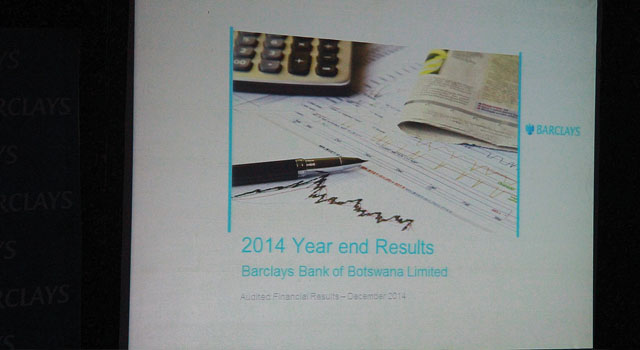Barclays Bank of Botswana has released its financial results for the year ended December 2014. The results of the Botswana Stock Exchange listed bank, with a market capitalization of over P3.2 billion, point to a marginal growth in revenue of 0.5% to P1.3 billion.
Income revenue dropped by 1.8% to P890, 902 million and the bank attributes this to the current low interest trading environment. Speaking at the results presentation event, Barclays Botswana Managing Director Reinette Van Der Merwe emphasized that “The key impetus for us is to increase our fee and commission income, particularly in our current environment of low interest rates. The Bank continues to be deliberate in continued investment in this business to ensure its future sustainability, while seeking to engage and involve our customers.” According to Van Der Merwe, the bank fee and commission income increased by 12.8% due to increased transaction volumes, insurance commission income, and new revenue streams from services such as Cash Send and Cash Deposit ATMs.
Insurance income is contributed by Barclays Insurance Services Limited, a wholly owned subsidiary of Barclays Botswana, which earns commission on all insurance policies sold on behalf of its principal. From this revenue, the bank realized P424, 836 million as profit before tax, a 5.6% growth when compared to what was garnered in the previous year. However, cost of operations went up by 4.7%. This Van Der Merwe attributes to “…investment in staff and leadership, as well as infrastructure – head office, intelligent ATM nationwide roll-out and the 3-in-1 Airport Junction Branch. Digital platforms like Paperless Banking and Remote Account Opening have been embedded into each branch in order to further enhance the overall customer experience.”
The Bank’s Total Capital Adequacy Ratio (CAR), a measure of a bank’s capital used to protect depositors and promote the stability and efficiency of financial systems, is sitting pretty. At 18.4%, it is way above the 15% supervisory limit and is sufficient to support the bank’s growth plans. Owing to credit strategy changes which focused on improving the performance of new bookings and improved collection execution, credit impairments went down 24.2% to P150.4 million. The Bank’s loan book grew 10.8% to P8.1 billion. This is attributable to a 9.6% growth in retail loans, both secured lending and term loans, and corporate loans, which increased by 17.5%. For the latter, the bank had focused on foreign currency lending which is not impacted by margin compression in the local market, and this they executed by supporting regionally outbound Botswana companies. The bank seems to be well in line with their 5 year TRANSFORM strategy, which among its key strategic areas was, according to Van Der Merwe, to “…grow our corporate and SME business, while selectively growing our retail secured portfolio. This growth will be achieved through optimizing our Balance sheet, while ensuring that we are continually investing in this business.” Barclays shareholders’ equity per share has grown 23.2%, and they will enjoy a 16% more earnings per share with a 11 thebe gross dividend per share already declared.
Van Der Merwe has decried difficult trading conditions, “2014 has marked a year of increased profitability against a backdrop of reducing interest rates, modest economic growth, freeze on fee charges and evolving market liquidity.” Going forward, the bank will continue the aggressive execution of its TRANSFORM strategy, which focus is “building a solid foundation to be the ‘Go-To’ bank in Botswana. Our investments are aimed at improving customer service and as such we will continue to invest in digital innovations as we strive to have an engaged and involved customer, which we view as our core growth opportunity. Colleague and leadership development remain an integral part of our investment strategy,” said Van Der Merwe.

